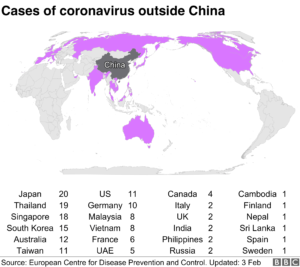You can’t turn on your television, open your social media feed, or even check your email without reading about the alarming coronavirus outbreak. As the virus continues to spread, so does panic, fear, and confusion.
The first reports of a strange virus triggering several cases of pneumonia in Wuhan, China made it to the World Health Organization on the last day of 2019. By Thursday, January 30th, the World Health Organization had officially declared coronavirus to be a global health threat as the 6th case in the United States was confirmed the same day.
Reports about this outbreak became more widely published and shared mid-January, when JFK airport in New York, LAX in Los Angeles, and SFO in San Francisco all began to screen passengers for the illness. As of Saturday, February 1st, there have been almost 12,000 reported cases, with over 2,000 being reported within the last day. Currently, the virus has killed a total of 259 people.
Here’s everything else we know about coronavirus as of now.

WHAT IS CORONAVIRUS?
According to the Center for Disease Control and Prevention, “Coronaviruses are a large family of viruses, some causing illness in people and others that circulate among animals, including camels, cats, and bats. The recently emerged 2019-nCoV is not the same as the coronavirus that causes Middle East Respiratory Syndrome (MERS) or the coronavirus that causes Severe Acute Respiratory Syndrome (SARS). However, genetic analyses suggest this virus emerged from a virus related to SARS.”
So, coronavirus is the name for a family of viruses that infect animals and humans. Specifically, seven strains of the virus are known to infect humans. This includes four strains that cause the common cold, Severe Acute Respiratory Syndrome or SARS, which was another headline-dominating viral outbreak, Middle East Respiratory Syndrome or MERS, and this newly discovered strain, known as 2019-nCoV, that is currently making its way across the globe.
HOW DID THE CURRENT OUTBREAK HAPPEN?
This outbreak is believed to have started in a seafood market in Wuhan, China, where the first cases were reported. At this specific market, animals like birds, snakes, and bats are bought and sold under illegal conditions. After extensive testing, bats have been identified as the original carriers.
Coronavirus can transfer from animals to humans. In the case of 2019-nCoV, the Wuhan seafood market that was hosting a wide variety of animals in close proximity to food and people created the opportunity for the virus to transfer from a bat to a person, triggering the outbreak that is shocking the world today.
Generally, coronaviruses are carried by a variety of animals like cats, cattle, and bats. However, it’s possible for the virus to spread from an animal to a person which then leads to the rapid spread of the virus among people. Viruses spread differently and currently there is a lot of research being done to better understand this never-before studied 2019-nCoV strain of the virus.
Most of the time, though, these viruses spread like the flu. Sneezing, coughing, and talking are all simple things that launch the virus into the air to be ingested by another person.
WHERE HAS THE VIRUS SPREAD TO?
Some of the earliest cases of 2019-nCoV occurring outside of Wuhan were reported from individuals who’d recently traveled there. Currently, there have been eight cases reported in the United States, occurring in: Arizona, California, Washington, Illinois, and most recently, Massachusetts. See the full timeline by reading this article by NBC News.
More cases are anticipated to be reported in the coming days and weeks with travelers and health care workers running the highest risk of contraction. Coronavirus spreads through exposure and those closest to the virus are at the highest risk of contracting and further spreading it.

WHAT ARE CORONAVIRUS SYMPTOMS?
Coronavirus symptoms for 2019-nCoV may include sudden fever and upper respiratory discomfort including a cough or shortness of breath. The symptoms appear to develop between two days to two weeks from contraction. Reported cases share a varied pattern with some individuals developing extreme symptoms and others passing away with almost none.
SIMPLE PROTECTION TIPS
Emerging research indicates that this strain of Coronavirus can survive on non-porous surfaces between three to twelve hours. This is problematic, especially considering its highly contagious nature. Simply coughing, sneezing, or talking is enough to project the virus into the air, reaching up to six feet away from the contaminated person.
Touching a contaminated surface, maybe a table or surface where someone coughed and left the virus, or shaking hands with an infected person who sneezed into their hands without washing them, is enough to contract it.
As this is a new virus that scientists and doctors are working rapidly to understand and contain, there is no vaccination available for 2019-nCoV. As with any infection, good preventative actions and habits are the besy way to protect yourself and those in your home, business, or facility.
- Consistent and proper handwashing, lasting a minimum of twenty seconds, with warm and soapy water is a first-line defense against the spread of infectious disease.
- If you can’t wash your hands, use an FDA-approved hand sanitizer proven to kill infectious diseases and make this available for those in your home, office, or facility.
- Do not touch your face to prevent the disease from entering your mouth, nose, or eyes.
- Practice good hygiene and properly use and dispose of tissues when you cough or sneeze, followed by proper hand cleaning practices.
- Keep high-touch surfaces sanitized throughout the day.
2XL FORCE WIPES AND HOW TO COMBAT CORONAVIRUS
2XL Disinfecting Force Wipes [2XL400/401] have demonstrated effectiveness against viruses similar to 2019 Novel Coronavirus (2019-nCoV) on hard, non-porous surfaces. Therefore, 2XL Force Wipes [2XL400/401] can be used against 2019 Novel Coronavirus (2019-nCoV) when used in accordance with the directions for use against Norovirus on hard, non-porous surfaces. Refer to the CDC website for additional information.
To buy Force Disinfectant Wipes or to learn more about them, please visit the 2XL Force Disinfectant Wipes Product Page.

